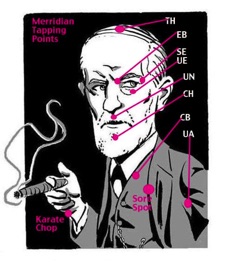Emotional Freedom Technique
The Theory

EFT has been described a needleless acupuncture for the emotions. In addition to the simpler, all-purpose tapping protocol, EFT also instructs people to speak affirmations and engage in unusual, yet seemingly effective behaviors, including tapping, eye movements, humming, and counting. Gary Craig, a student of Roger Callahan, developed EFT, by combining EMDR’s eye movements and emphasis on shifting underlying cognitive belief systems with a more generalized acupressure point tapping, based on TFT. One cycle of EFT takes only a few minutes, generates little distress and it can be effective even if the client does not believe that it would be. There have been no formal research studies done to empirically prove efficacy of these acupressure techniques. However, clinicians and clients alike seem impressed with the results that they’ve been getting (author included).
According to van der Kolk, et al (1996), effective treatment requires exposure to, without total re-experiencing of, the traumatic material; too much arousal precludes assimilation of any new information. It may be that the tapping protocol in TFT and EFT provides a concrete physical stimulus drawing attention back to the here and now, anchoring clients in the present. It also appears that the physical, rhythmic stimulation has a calming and soothing effect on agitated clients. This is most likely produced by the reciprocal inhibitory relaxation response of the parasympathetic nervous system’s reducing the effects of the hyperactivated sympathetic nervous system (Carbonell and Figley, 1995). In EFT, you tap gently on certain acupuncture meridians on the face and the body as you tune into the problem you want to resolve. The tapping process, combined with your focused attention on the issue you want to resolve, can reduce physical and emotional pains, end cravings/habits, and relieve anxiety, fears and phobias, sometimes with remarkable speed and often with long-lasting positive effects.
Interview: EFT with Belleruth Naparstek
Click to View An Introduction to EFT with Judy Byrne
The Tools
The EFT “Basic Recipe”
Usually one can learn the basic recipe within a few minutes. Once familiar with this process, you can do the whole round in under 2 minutes.
Before You Begin
Identify the specific problem and observe how it feels: thoughts, sensations, and emotions that are associated with the issue. Using a SUDS (Subjective Units of Distress Scale) rate your distress from 0– 10 (0=no distress, 10= the worst distress you can imagine)
Follow the four components of the “Basic Recipe”
1. The Setup
Start your EFT process by tapping firmly on your Karate Chop point.
Setup Phrase: Next, bring up the negative emotion and/or problem you want to address.
Note the SUDS level from 0 to 10 (0=none 10=worst).
Then say the following statement three times and with some degree of conviction, (aloud if possible-though not necessary), as you firmly tap on the Karate Chop point: “Even though I have this _____________, I accept myself.” (Fill the blank with the negative emotion or issue you want to address.) For example: “Even though I have this craving for chocolate, I completely accept myself” or “Even though I feel so angry at him, I completely accept myself.”
2. The Sequence
Once the setup step is complete, place your index finger and middle finger together.
Using the tips of these fingers, tap about seven times on each of the following meridian points.
Tap firmly, but not so hard that you bruise or hurt yourself. (Most of the tapping points exist on either side of the body. It doesn’t matter whether you tap on the right side or the left, nor does it matter if you switch sides during the Sequence. For example, you can tap under your right eye and, later in the Sequence, tap under your left arm.)
As you tap on these points, it is necessary to keep your mind tuned to the issue you are resolving with EFT.
To do that, say a Reminder Phrase: “This ________________ (issue)...” as you tap on each of the points.
Using the above example for the problem of chocolate craving, the Reminder Phrase would be, “This craving for chocolate.”
Going down the face and the body, gently tap on the following points as you say your Reminder Phrase, “This ________________ (issue),” starting from:

EB = Beginning of the Eye Brow (either the left or right one).
SE = Side of your Eye (of either left or right eye, tap on the boney part the eye socket right at the corner of your eye.
Don’t get too close to the eye that you hurt yourself, but don’t go too far off that you are tapping on your temple.)
UE = Under the Eye (of either left or right eye, again on the boney part of the eye socket, about 1 inch below the pupil.)
UN = ose and the top of the lip)
CH = Chin (midway between chin and the bottom of lower lip).
CB = Beginning of the Collar Bone (where the breastbone, collarbone, and first rib meet)
UA = Under the Arm (about 4 inches below your arm pit on either side).
TH = Top of the Head
Sore Spot
Karate Chop
3. The 9 Gamut Procedures
After completing the Sequence, you are now ready to carry out “The 9-Gamut Procedure.” This procedure fine-tunes the brain via eye movements, humming, and counting so as to enhance the effects of the tapping. It tunes the brain to the right frequency for the problem. Through connecting nerves, certain parts of the brain are stimulated when eyes are moved. Likewise, the right side of the brain is engaged when you hum a song and the left side is engaged when you count. During this procedure, nine of these brain stimulating actions are performed while simultaneously and continuously tapping “the Gamut Point.” While continually tapping on the Gamut Point, carry out all the following:
Brain-Balancing steps
1. Close your eyes
2. Open your eyes
3. Eyes hard down right while holding the head steady (stimulates kinesthetic sensations and memory)
4. Eyes hard down left while holding the head steady (internal dialogue)
5. Roll the eyes in a circle clockwise (stimulates visual and auditory memory and imagination)
6. Roll the eyes counter-clockwise (as above)
7. Hum “Happy Birthday”, or any song, for 2 bars (this engages the right brain)
8. Count to 5 (this engages the left brain)
9. Hum “Happy Birthday”, or any song, for 2 bars again (this engages the right brain)
4. The Sequence (once again):
After completing The 9-Gamut Procedure repeat the whole Sequence.
Take a Deep Breath, Check-In, and Reassess.
After each round of EFT, take a deep breath in and gently breathe out.
Take a moment to check in with yourself.
Notice how you are feeling now, physically and emotionally; notice what thoughts, memories, or emotions are up for you
Without judging yourself right or wrong, just observe.
Next, reassess the intensity level of the problem.
What is the intensity level now? If you are at a 0, you are done.
Congratulations! If not, you may need to do one or more subsequent rounds until you feel the intensity has gone down to 0.

